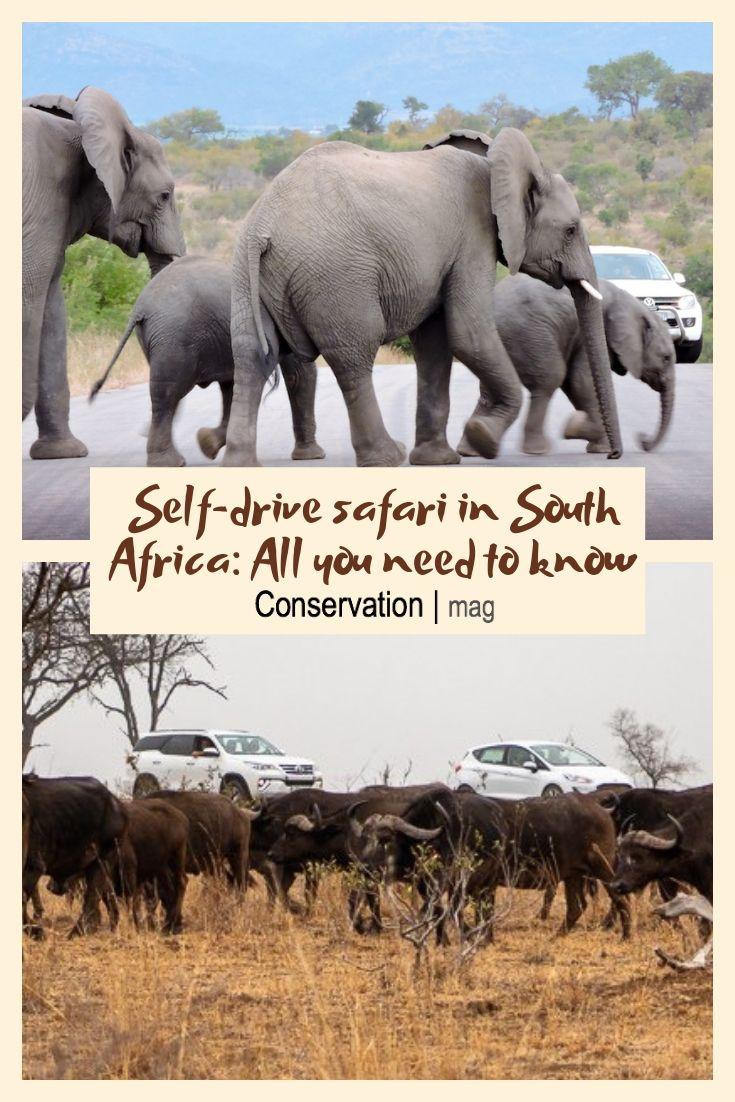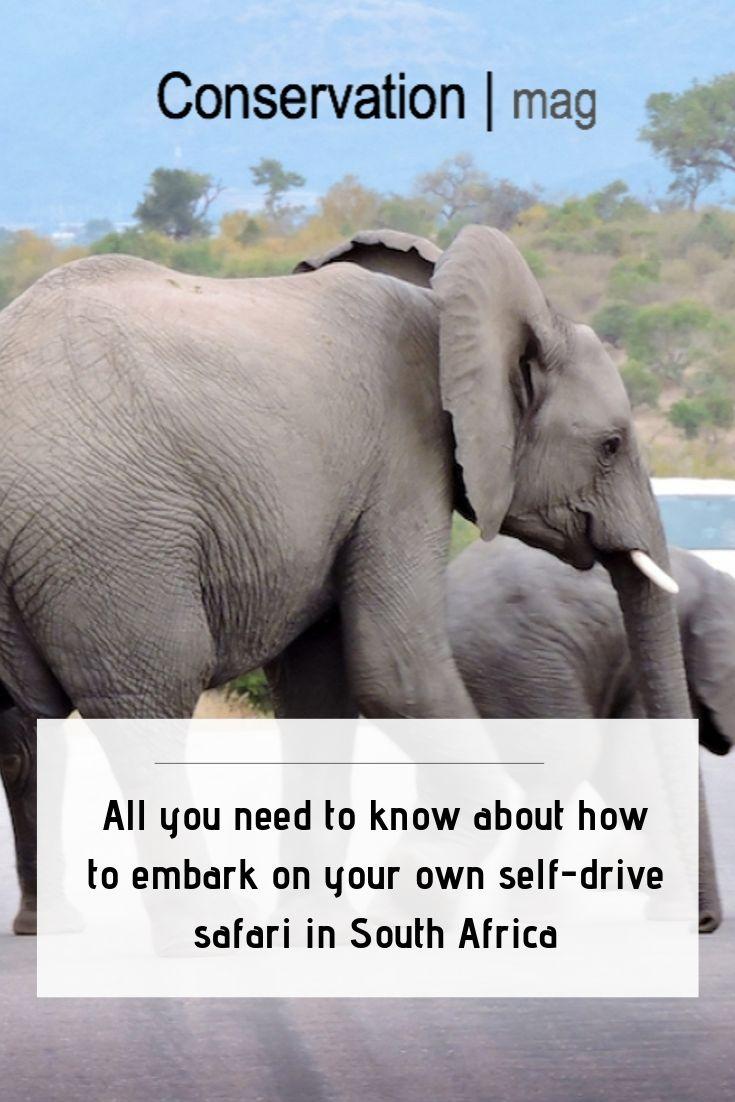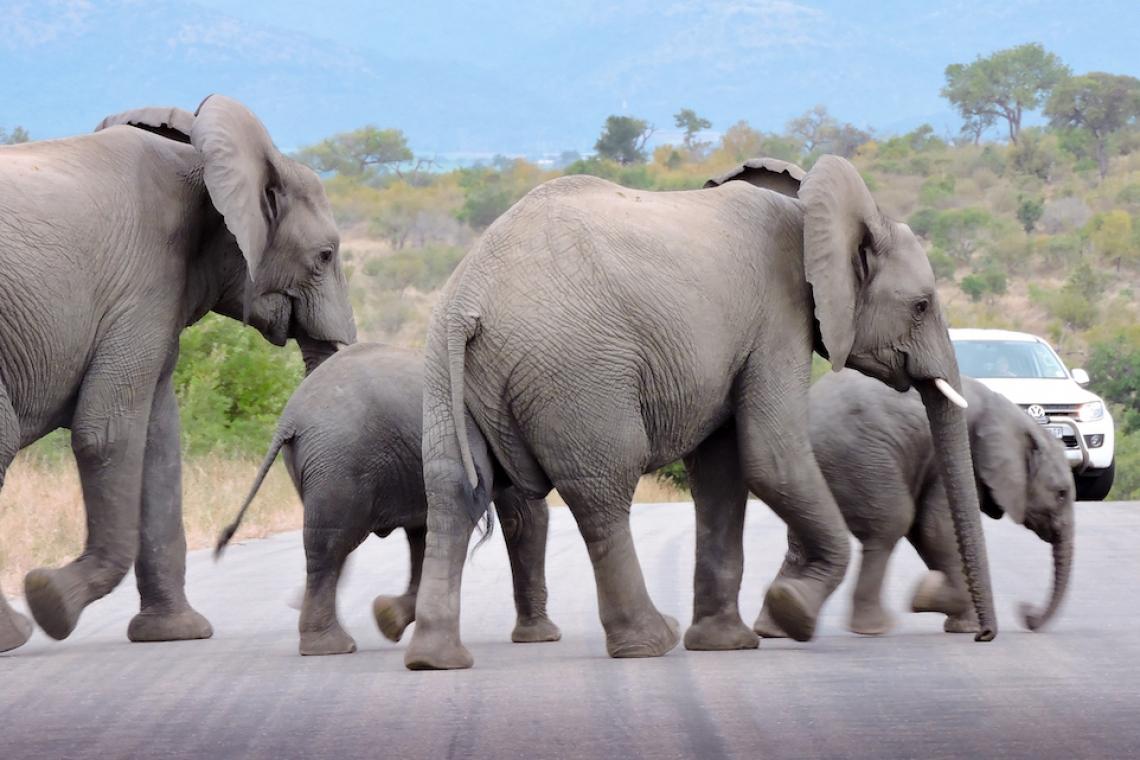Everything you need to know about going on your own self-drive safari in South Africa
Did you know that you don’t need to go on an organised tour or game drive to go on safari in South Africa? The idea that you can drive around a reserve yourself spotting wildlife (including the big five!) is actually amazing.
Giraffe at Pilanesberg National Park - Claire White

If you’ve not been on a self-drive safari before the notion can sound daunting. What if I get charged by an elephant? What if my car can’t cope with the roads? What if I get lost or stranded?
However, going on your own safari is actually really easy, safe and very enjoyable. Every photo in this post was taken from a self-drive safari either in Dinokeng Game Reserve, Mabalingwe Nature Reserve, Pilanesberg National Park or Kruger National Park.
Why go on a self-drive safari?
- It is usually very cost-effective, especially if you are travelling in a group. Park entrance fees tend to be very reasonable (even the international rates). You will need to pay a rate per person and one for your vehicle, then off you go.
(For example, an international visitor to Pilanesberg National Park will pay R110 each, plus R40 for their car. That equates to around £8.30 or $10.46). You then have more choice when it comes to accommodation and can pick something to suit your budget).
- It offers fantastic flexibility in terms of your overall schedule and the safari itself. You can spend the whole day in the reserve if you want. Go at your own pace and stop when and where you like to take in the wildlife and the landscape.
- It is great fun trying to spot the animals yourself.
- It can be a viable alternative if your children are too young to take part in an organised game drive.
Where can you go on a self-drive safari in South Africa?
You’re in luck! Not all countries are geared towards self-drive safaris in the way that South Africa is. There are a number of places you can embark on your safari.
National Parks:
Kruger National Park
Pilanesberg National Park
Addo Elephant National Park
Marakele National Park
Kgalagadi Transfrontier Park (4×4 required for this one)
Find out more about my self-drive safari experience in Pilanesberg National Park here.
Occasionally private game and nature reserves do allow you to drive round them such as:
Dinokeng Game Reserve
Mabalingwe Nature Reserve (no day visitors, guests only)
Hluhluwe-Imfolozi Park
However, for the most part private game reserves don’t allow day visitors or self-drive safaris. If you are keen to go on a self-drive safari, I recommend you check beforehand if the destination you have in mind allows it.
Top tip: particularly in peak season parks can get busy and some do have quotas for how many vehicles they allow in each entrance gate, such as Kruger National Park. Therefore, I would suggest you either book ahead (if possible) or arrive early. Research the park online before you go so you know what to expect and avoid disappointment. Visit the South African National Parks website here.
Female kudu at Dinokeng Game Reserve - Claire White

What car should you take?
For the most part you don’t need to go out and hire a fancy 4 x 4. But a car with a higher undercarriage such as a small SUV (e.g. Toyata RAV4) can be really useful. As well as giving you a better vantage point for game viewing, it is also helpful for the bumps and roomier so everyone in the car is more comfortable during the safari.
Typically, there can be a mixture of tar and unpaved roads in reserves, but this can vary. A normal sedan should be able to negotiate most unpaved roads, but perhaps not all. Usually there is signage or information regarding which roads to avoid. You should also be a bit more cautious if it has been raining recently.
The exception to the above is Kgalagadi Transfrontier Park where you would need a 4×4 as the terrain is more adventurous. Aside from this all the parks and reserves I’ve listed can be negotiated in a normal sedan or SUV, provided it has not rained heavily.
Elephants cooling off in the midday heat in Pilanesberg National Park. There were actually three elephants, but two of them are almost completely submerged - Claire White
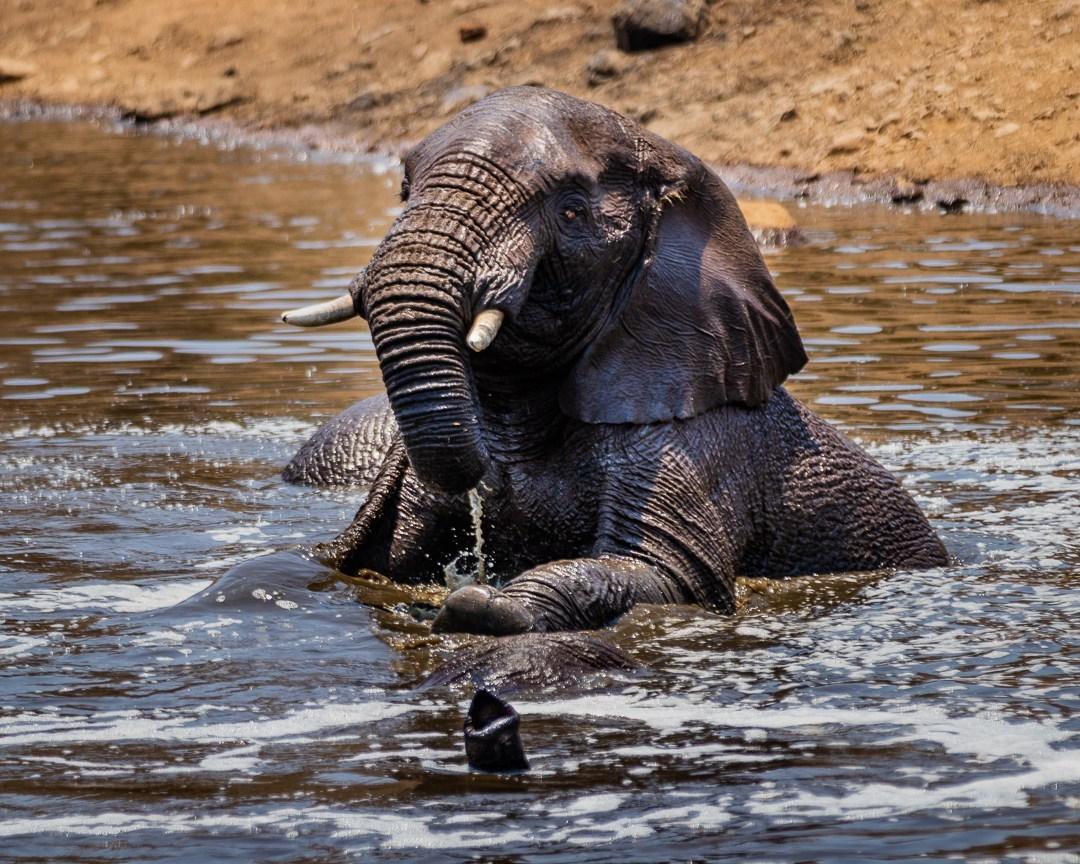
What you should expect on a self-drive safari?
A self-drive safari is exactly what it says on the tin. Visitors pay an entrance fee then drive around in their car to try to spot some wildlife. You’ll be driving slowly and stopping often, and can stay for a few hours or for the whole day. Whatever takes your fancy.
There are designated rest stops or hubs that usually have toilets, a shop and perhaps a small café. Some do also have braai facilities for visitors to use. You may be able to visit a game lodge for a coffee or for lunch, but you should check beforehand which lodges allow this, as not all do.
In larger parks such as Kruger you will find fuelling stations within the park, but for the most part ensure you have enough fuel before entry.
Park Rules and Etiquette
These will vary depending on which park you are visiting and are usually common sense. Any information you are provided with at the gate should be read thoroughly and adhered to.
The below is generally what you would expect.
- Stay on the roads at all times. Under no circumstances are you allowed to go off the marked roads. This is for your safety and the animals as well.
- Don’t get out of the car under any circumstances unless you are at a designated rest area or signage indicates you can. You will need to wait until you reach a rest stop to go to the toilet, so always factor this into your visit.
- Don’t play loud music and keep noise to a minimum.
- Adhere to the gate closing times. If you are in the park after hours you will be fined. There are seasonal variations to opening times, so check before you enter.
- Don’t be discourteous. There are some visitors that stop in the middle of the road at an animal sighting. They block the road for everyone else and don’t give others the access to enjoy the animal sighting either. I appreciate that most people don’t mean it, they are just enthralled by the wildlife, but don’t be one of those people. Let others enjoy the experience as well!
- If you’re driving slowly admiring the view or looking for wildlife always let others pass if they would like to.
Zebra close-up at Pilanesberg National Park - Claire White
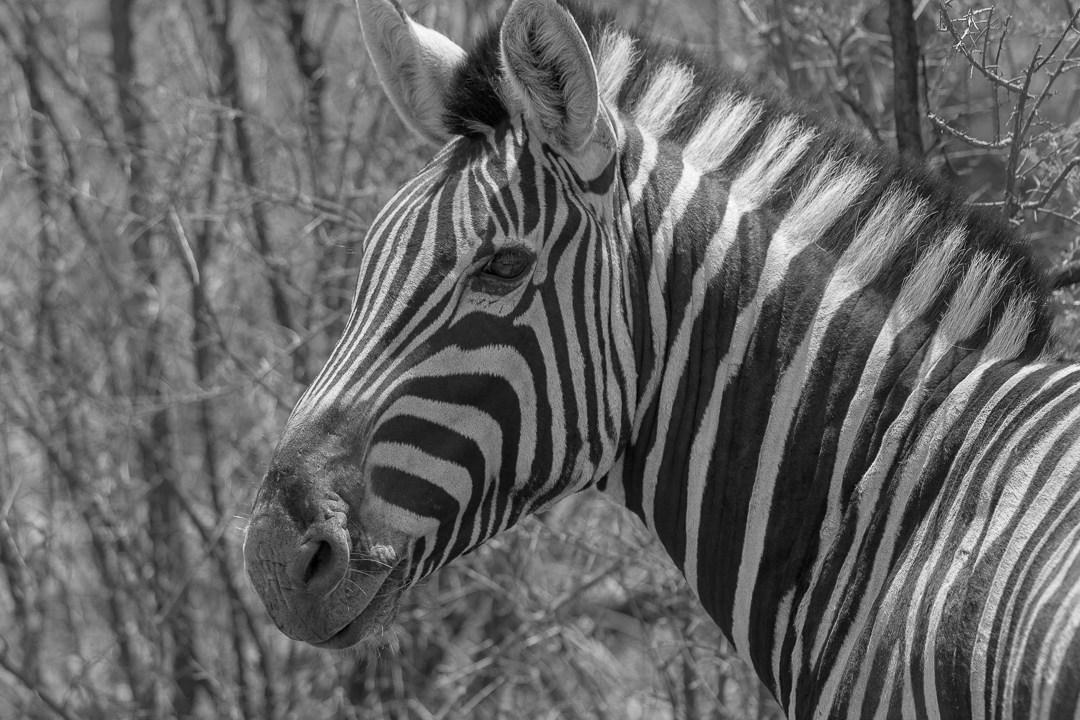
Wildlife Viewing Tips
Don’t worry, on a self-drive safari you are sure to see some animals. However, you can maximise your experience by following these tips.
- Plan your route before you go but be flexible on the day and don’t be too ambitious. The speed limit might well be 40km per hour but remember you will be driving very slowly and stopping often to look at and photograph animals.
- Arrive early. Predators in particular are more active in the cooler morning hours. However, that’s not to say that you won’t come across wildlife at any time of the day.
- Take binoculars and an animal/bird reference book with you.
- Check out Twitter and other social media platforms for postings about animal sightings. Perhaps there is a lion kill around the next corner or a stationary leopard? You never know.
- Lodges and rest camps tend to have boards outside with information regarding recent sightings.
- Don’t be afraid to stop someone else driving around to ask if they’ve seen anything. You’ll find most people really friendly and eager to share their knowledge.
- If you see a few game viewing vehicles have stopped in the same place it usually means they’ve seen something. If there is enough space, go over and take a look or wait until they’ve moved off.
- Stop off at waterholes, dams and rivers to look out for animals coming to drink and water birds.
- Especially in the heat of the day look under trees for animals trying to catch some shade. Also, don’t forget to look up in the trees for leopards. Later on you may find animals such as lions and hyenas lying on tar roads as the surface retains the heat from the day.
- Keep an eye on animal behaviour. You don’t need to be an expert, but signs such as skittish antelopes, squawking birds or screeching baboons could mean there is a predator nearby, so it may be worth lingering a while to see.
- At a sighting switch off your engine and really enjoy the experience. This means you can use all your senses. Listen to a rhino snorting, a zebra cropping grass or find out how smelly lions really are.
- Be patient and don’t have too many expectations. There won’t be an animal around every corner and you could go for stretches without seeing any wildlife. However, the animals are there and you’re sure to see some.
- It can get surprisingly tiring continually scouting for animals. If you find yourself staring vacantly into the middle distance, make your eyes scout from the far distance towards you, then back again. This will keep you alert and constantly looking.
- Don’t forget to look at the view. There are some amazing landscapes to enjoy as well as the wildlife. Ensure you take some time to appreciate the environment as well. If there are any high points in the reserve you are visiting try and factor them into your plan for the day.
Impala baby at Pilanesberg National Park - Claire White
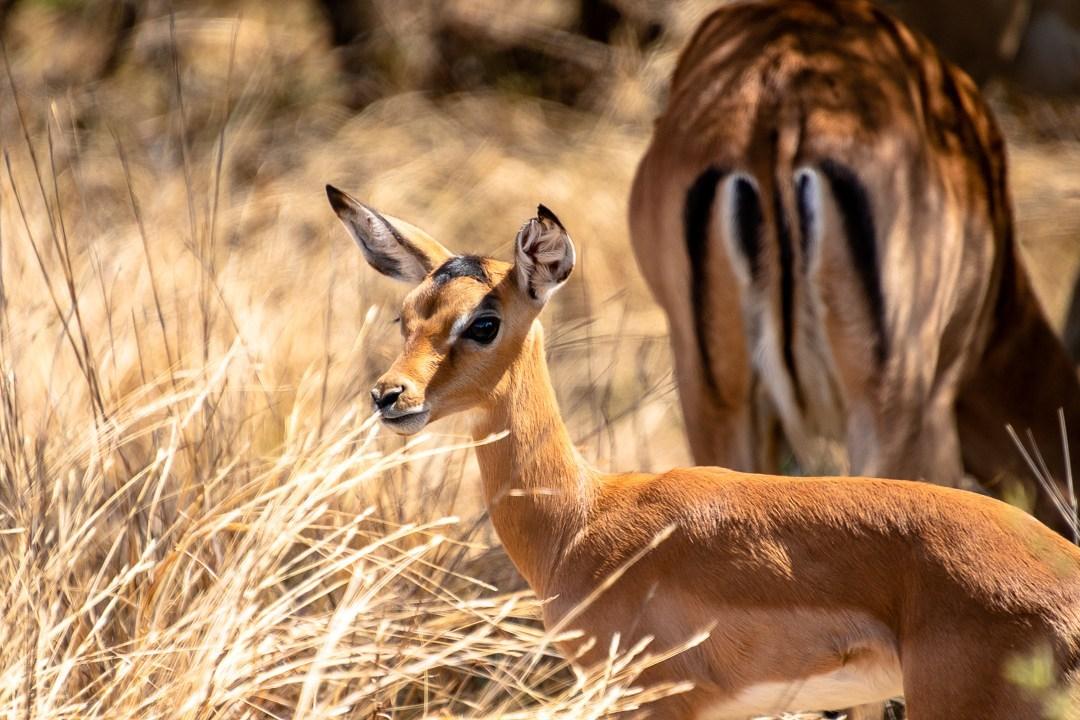
Are there any negatives to a self-drive safari?
There are no negatives as such to a self-drive safari, but you should be aware that it is a different experience to an organised game drive.
On one of these your vehicle is higher up and usually open sided. Your guide will be able to identify animals and should be able to tell you about them as well. Given rangers communicate over their radios they may also have some insider knowledge about where to find animals. But you won’t have the same flexibility as you would on a self-drive (unless you fork out for a private one). Whilst your ranger will be happy to stop, they also need to try and accommodate all their passengers.
I get asked quite a bit regarding which one I prefer. My answer is that I like a bit of both, as both are exciting and fulfilling in their own ways. Plus, the cost-effectiveness of a self-drive safari is very appealing.
If you’ve not been on a safari before I would suggest that you try an organised game drive first. This will give you an idea of what driving in a game reserve is like and a grounding in animal identification and behaviour. If you have any concerns about your self-drive safari you can also quiz your ranger. Following this embark on your own self-drive safari.
White Rhino at Pilanesberg National Park - Claire White
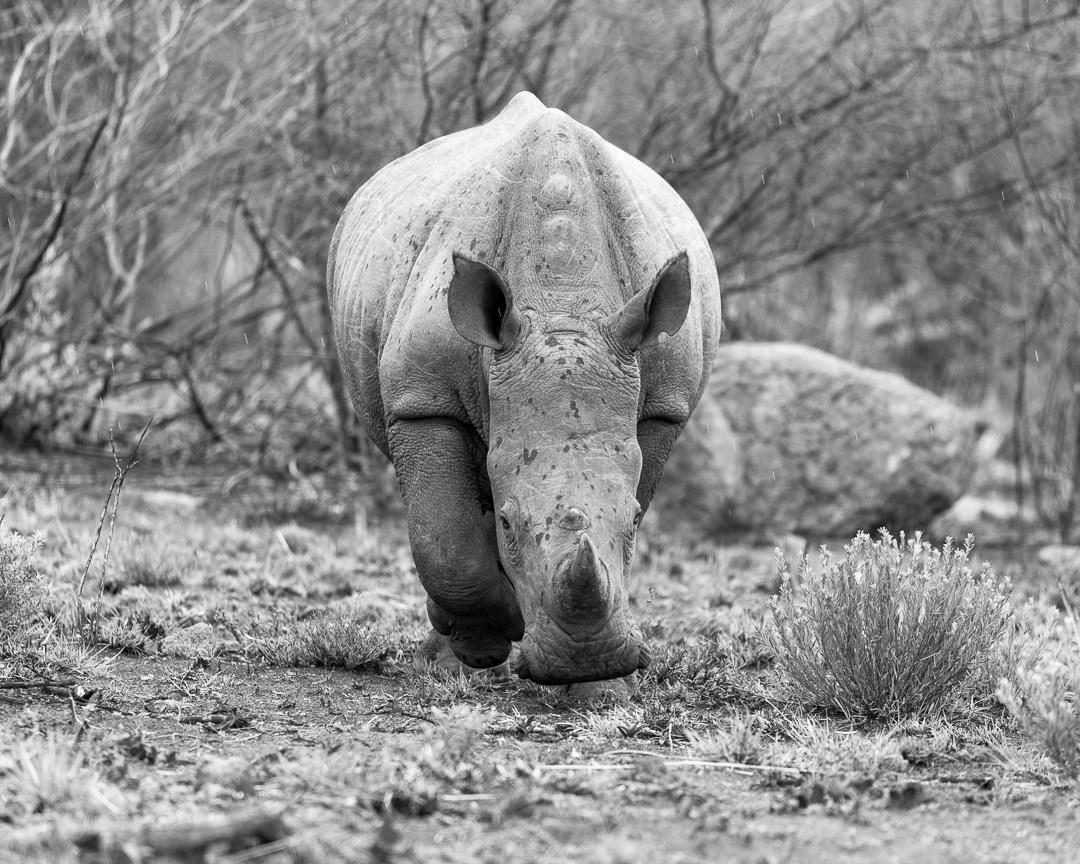
Staying safe
It can be tempting to try and get as close to the action as possible in your car to get the best experience and the best photographs.
However, it is also a daunting prospect coming face to face with an elephant or another large mammal. You’ll realise how truly small you are. Ensure you don’t approach animals too closely, particularly larger animals such as elephants, rhinos, buffalos and hippos.
Buffalos in particular are known for their unpredictability. They can look sedate one minute then be charging the next. Steer clear of buffalo bulls in particular.
Where elephants are concerned the main issue is if a bull elephant is in musth. This is when they will have an overwhelming urge to mate due to heightened levels of testosterone in their systems. This testosterone will also make them aggressive. The most obvious tell-tale signs are if the elephant has weeping glands between their eyes and ears or they are constantly dribbling urine. Again, the advice here is to keep your distance.
Baboons and monkeys can also be troublesome. Don’t be fooled by cuteness! They have very nifty fingers that can open doors, climb through windows and all sorts. They will usually be after food, and this can make them aggressive. Have you seen how large a baboon’s teeth are?
Blue wildebeest at Mabalingwe Nature Reserve - Claire White

Tips to stay safe
Keep your windows up and your doors closed and locked. Do not lean out of the window and keep all limbs inside the vehicle. If you are travelling with children, ensure the child locks are on the windows and doors. At a recent visit to Pilanesberg National Park we saw a van with both sliding doors open, and as if this wasn’t bad enough it was at a lion sighting. This is taken very seriously. Our ranger radioed park officials to kick them out due to their behaviour.
If you’re looking out of the window, keep the opposite one closed. Open your window at a sighting to take a photo by all means but you should still be very aware and if it is a close encounter with a predator or a baboon consider keeping it closed. Remember, that a lion can be the height of the top of your window in a small car (google this if you don’t believe me).
Give animals plenty of room! Just because there is a car in front of you practically touching an elephant’s bum it doesn’t mean you should be doing the same thing.
If animals are in the road then they have right of way. Even if you’re in a hurry or are just feeling a bit impatient today then you’ll simply have to wait. At Kruger National Park we recently found ourselves in a traffic jam caused by hundreds of buffalo crossing the road to reach a waterhole. There was nothing for it but to sit back, relax and have the camera at the ready.
Just a couple of hundred buffalo or so passing through… - Claire White
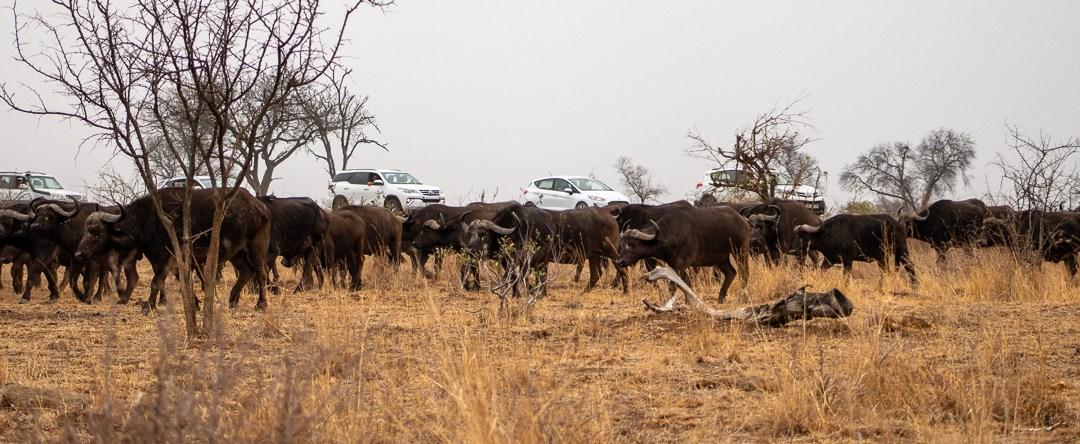
You could also find yourself in the midst of a herd of elephants while you’re stationary for instance. If this happens remain calm, and simply wait for them to pass.
Don’t just be looking out for the bigger animals on the road. Be sure to keep an eye out for smaller animals crossing such as rodents, snakes and insects. You really don’t want to run over the wildlife.
Remember to look at the animal’s behaviour. Does it look agitated? If the animal continues to eat despite your presence, then you’re good as it usually means they are feeling relaxed and comfortable enough to carry on with daily life. If they are not eating and are showing signs that they are bothered by your presence back away slowly or give them a wide berth altogether. Bear in mind animals with babies will have their protective instincts on high alert as well.
Remain alert at all times. There may be points such as rest stops, viewpoints or picnic spots where the signage indicates you can leave your vehicle. Some of these are unfenced and it will be at your own risk. Keep in mind that the animals don’t know that this is a designated rest stop for humans. Look around before you get out the car, remain alert and keep children close at all times. If you see an animal don’t move towards it and definitely don’t run, as this could cause the animal to give chase. Pick up young children and back away slowly to your car or a safe place.
We recently popped into a rest stop in Kruger National Park and found an elephant lurking on the outskirts. Visitors were getting incredibly close to take selfies. The elephant looked fairly relaxed (I think?), but it is still an enormous wild elephant. So, just because everyone else is practically stroking it, it doesn’t mean you should be as well.
Keeping out the way, unlike some people… - Claire White

Checklist for what to take with you
Remember to ensure anything you need is taken out of the boot of your vehicle before you enter the reserve, as you can’t just hop out the car to fetch items on the go.
- Plenty of water. A self-drive safari is thirsty work!
- Snacks to keep you fuelled
- Picnic lunch (if applicable)
- A map of the reserve (some reserves hand these out at reception or you can purchase one if not. From previous experience you’d need to buy one at Kruger National Park. Alternatively print a map before you go).
- Mobile phone
- Emergency telephone number for the reserve
- Camera
- Binoculars
- Animal / bird reference book
- Sun cream
- Insect repellent
- Entertainment for children (if applicable)
- The Lion King sound track (just to set the mood)
By now you should be all set to embark on your self-drive safari in South Africa.
Do you have any other questions before you go? visit AcaciaDiaries http://acaciadiaries.com/2019/02/18/how-to-embark-on-your-own-self-drive-safari-in-south-africa/
Main image by Adriaan Buys all others by Claire White
Shop for a cause
Shop on amazon.com | amazon.co.uk
